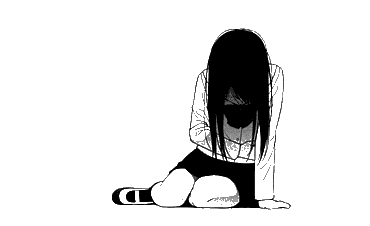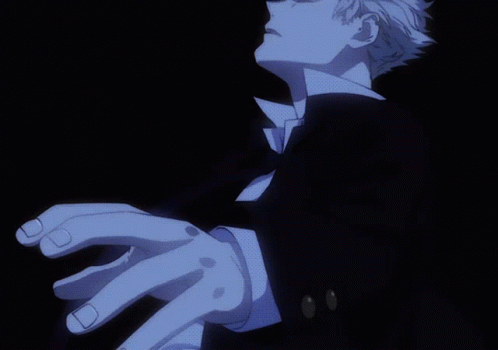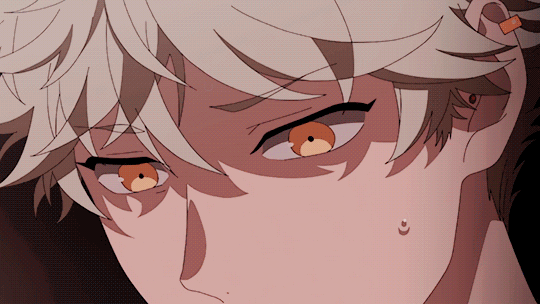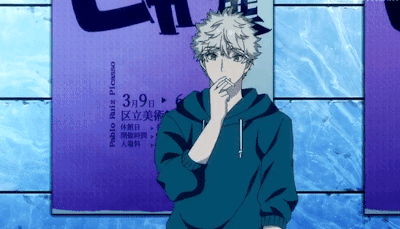BLUE PERIOD
STATUS
COMPLETE
EPISODES
12
RELEASE
December 11, 2021
LENGTH
24 min
DESCRIPTION
The studious Yatora leaves a dry life of study and good manners behind for a new passion: painting. But untethering yourself from all your past expectations is dangerous as well as thrilling…
(Source: Kodansha USA)
Note: The anime premiered on Netflix on Sep 25, 2021 in Japan. The TV broadcast started on Oct 2, 2021.
CAST

Yatora Yaguchi

Hiromu Mineta

Ryuuji Ayukawa

Yumiri Hanamori

Maki Kuwana

Yume Miyamoto

Yotasuke Takahashi

Daiki Yamashita

Haruka Hashida

Kengo Kawanishi

Maru Mori

Mayu Aoyagi

Mayu Ooba

Yuuki Kazu

Masako Saeki

Fumi Hirano

Kinemi Miki

Kana Hanazawa

Koigakubo

Shinichirou Kamio

Hanako Sakuraba

Saori Oonishi

Fumi Kamiyama

Atsumi Tanezaki

Utashima

Tatsumaru Tachibana

Shirota

Yuna Nemoto

Sumida

Masaya Fukunishi

Yuki Kuwana

Sayaka Oohara

Umino

Miku Hiratsuka

Sae Okada

Emiri Suyama

Shirai

Ikumi Hasegawa

Yamamoto

Aoi Koga

Takurou Ishii

Taishi Murata

Kanshu

Ryousuke Takahashi

Atsuko Takahashi

Ayumi Tsunematsu
EPISODES
Dubbed

Not available on crunchyroll
RELATED TO BLUE PERIOD
 MANGA DramaBlue Period
MANGA DramaBlue PeriodREVIEWS

AnimeDweeb
70/100Manga Better, and Why That's OK.Continue on AniList#Beauty lies in the eye of the Beholder, 
and the way us beholders perceive beauty will vary from person to person. It's this subjectivity in tastes that gives art its special meaning. So it's kinda poetic that a story all about art would turn out so divisive among those who watched it. The anime adaptation Blue Period (BP) has had people talking for less-than-ideal reasons. Extreme reactions between fans and skeptics can make it difficult for newcomers to decide if this anime is for them. This is because the anime commits specific faults that largely alienate those who have already enjoyed the original manga, and studio Seven Arcs' deserves plenty of criticism for how this material was handled. But let's resist the urge to paint with broad strokes here; despite its weaknesses, BP still manages to retain the core strengths of its source, and offers a valuable gateway experience for the uninitiated to appreciate. To anyone struggling with mixed feedback surrounding BP, I hope to offer an open-minded second opinion on whether or not to give this show a shot. This article will feature a usual breakdown of the story, as well as my honest thoughts on Seven Arcs' efforts when compared with its source material. I'm not here to endorse one medium over the other. My only goal is to endorse a story well-told in either form. And if there's one thing both manga enthusiasts and anime-only fans can agree on, it's this: BP is beautiful. Let's paint a holistic, spoiler-free picture of why BP deserves your time. (Tl;Dr below.)
#The arts can't be perceived in black and white.
#####Well, unless it's in monochrome, of course.It's common to generalize this field as one where stoner artists get praised by rich people for putting together silly sculptures and drawings devoid of meaning. Hyperbole aside, the stigma surrounding the arts is very real. Some revere the arts as a cultural necessity, others see it as a means of exploring themselves creatively. But people typically look down on the arts as a pointless career path, and this is a perspective shared by the main character of this tale. Yatora Yaguchi is a teen who has got it all figured out. He's quite the enigma when we first get to know him: a second-year with a delinquent's demeanor and a star student's grades. As it turns out, his crooked smile is part of a carefully-crafted prodigious persona that masks his hard work and effort. The driven Yaguchi takes pride in meeting the expectations of those around him and finding success in "real life." With an academic record on-track to securing placements in the country's top universities, there's no room for the illogical distractions that art presents.
But damn, if that angelic portrait isn't the most captivating thing he's ever seen.

Stumbling upon a beautiful piece in the Arts Clubroom, Yaguchi confronts what it means to create art. As his teacher Saeki-sensei puts it, the visual arts is spoken in a language without words, communicating truths unique to each artist. All his life, Yaguchi had convinced himself to seek success in school and social circles, but only because the world told him these things held value. Rather than fit in the "real" world, art offers Yaguchi the opportunity to create his own world. To tell his truth, to have his creations touch the lives of other people, to paint a Shibuya skyline, drenched in blue. Art is more than the physical pieces contained inside museum walls; it's passion, something that's been sorely missing from Yaguchi's joyless life.
Yaguchi's initial apprehension towards the arts comes from the overwhelming uncertainty of what lies ahead. Occupation in the arts is undervalued, and career prospects are dim. Artists fight tooth-and-nail in a competitive landscape to keep on doing what they love. Yaguchi is about to jump right in the thick of it, with his eyes set on his only viable path: the Tokyo University of the Arts, a public school with a 0.5% acceptance rate. Experiences in the Arts Club and prep school reveal a frightening catch-up game between our "prodigy" and his peers. He may have mastered what it means to be a conformist, but the arts is a place where individualism matters above all else. Instead of meeting expectations set by others, Yaguchi is now tasked with creating those expectations for himself. For the first time in his life, he perceives himself as a Salieri to the Mozarts of the art world ‒ a talentless amateur when compared against creative geniuses. There's little easygoing with such a tremendous challenge, but Yaguchi has never felt more alive.
#BP exudes love for the arts, and that same passion rubs off on its audience. This engaging effect is all thanks to mangaka Tsubasa Yamaguchi's laborious attention to detail. Stemming from both real-life interviews and Yamaguchi's time in Tokyo University of the Arts, Yaguchi's struggle as an upcoming artist feels earnest and intensely personal. His creative process, concerns, and insecurities are laid intimately bare. BP all but drags us into Yaguchi's headspace, which offers an interesting blank canvas for exploring what it means to grow as an artist. His sporadic spurts of self-confidence and artistic output can feel like he's regressing at times, but these flaws rarely come across as contrived. Rather, his struggles and encounters with dead ends make Yaguchi feel human. BP's character drama does have some corny moments, but otherwise depicts this crucial period in Yaguchi's life with a gripping air of maturity. Alongside a compelling protagonist are other inclusions that aid in connecting with this artistic journey. BP is remarkable in how it makes most viewers get art, even without prior knowledge on the subject. "Art within art" is key to the series' success. In-universe artworks derived from both fiction and real history act as markers for Yaguchi's progress, by communicating the qualities associated with good and bad art respectively. Each painting contains observable details in composition and quickly condenses important information ‒ a picture is worth a thousand words, after all. These artworks in BP brings the audience up to speed on topics Yaguchi studies; such as lighting, form, texture and perspective. And despite the textbook jargon, BP's "lessons" rarely feel dry or difficult, but rather come across as intuitive observations from a real person who was once in our uninitiated shoes. Through learning the technicalities and approaches involved with the production of art, viewers cultivate a deeper appreciation for the creations and struggles Yaguchi endures. The arts homage doesn't end there; BP is brimming with frequent factoids about art and references to famous pieces from the past. Now, there is a small downside when factoring in BP's side characters; the spotlight on Yaguchi often means that many often take a backseat. Still, I believe the series does a fantastic job at contextualizing the journeys of other artists. For instance, the talented Kuwana is in constant fear of failure, with her tenacity wearing thin under the weight of extreme expectations and the guilt of seeing the end of fellow artists' dreams. Probably the strongest showings from this secondary cast belong to Ryuuji. After an introduction which seemed to have got off the wrong foot, Ryuuji quickly came to steal the show through their earnest search for self-identity.
As someone who has recently done some mild studies in the arts, I have nothing but glowing praise for how BP tackles such niche talking points in an inclusive way. With the exception of last season's sleeper Kageki Shoujo, I haven't encountered any other anime that portrays such an infectious passion for the arts. Unfortunately, this appeal is far from universal, with regards to this anime adaptation at least. This is often the case with many adaptations, but more so with BP. The significant overlap between detractors of this TV series and those who have enjoyed the manga beforehand is worrisome and deserves a closer look. So without further ado, it's time to ask the age old question:
#"**Is the manga bett-**" Yes. 100%. 
I don't think there's any dispute over the notion that the manga is built different. One of the first differences you'd notice between manga and anime are the different stylistic approaches. The manga uses shading, linework and framing in a distinct way. BP's anime unfaithful visuals feel far flatter and bland by comparison, and its attempts at emulating the source's inspired use of imaginative sequences feel like phoned-in visual gimmicks. Another issue worth pointing out involves what was left on the cutting-room floor. BP's anime is paced really quickly, and starts out adapting ~100 pages per episode. The abridged result can feel more repetitive at times, and Yaguchi's huge screentime sometimes feels tiresome. Furthermore, the anime is at a disadvantage when it comes to explaining art concepts. From what I've discovered, audiences tend to have a better time keeping up with the manga, which has more room to present infographics and visual representations of this technical material. Finally, the observation that hurts the most is the claim that the anime is "emotionless." Manga readers do have a point; Yamaguchi's superb panels are more emotive and intense than what the anime can provide. And we've yet to mention BP's mediocre production quality, which often results in clunky frames and skewed facial expressions. So yes, manga is better… but that goes without saying for countless adaptations. So what's the problem? Well, word around the community is that BP is a bad anime, and this is a stance I wholly disagree with. Yes, BP's visuals are certainly conventional, but this is an approach that complements the more down-to-earth character drama the series is strong for. Yes, the anime starts out with very fast pacing, but Yaguchi's development in these first chapters is surprisingly on-par with the "rushed'' character changes in BP's first episodes. Yes, there is cut content involving artistic processes and Yaguchi's high school classmates (who show up as afterthoughts,) but the core of the story remains intact; Yaguchi's growth as an artist still takes centerstage to compelling effect. Yes, the anime could be seen as "emotionless," but mostly in comparison to the manga. Shift the playing field, and you just might realize that despite the average-at-best visuals and abridged content, Yamaguchi's unmistakable passion for the arts still resonates to a greater degree than most SoLs out there. If you're a seasonal binger who confuses Blue Period with Blue Lock, what this adaptation offers aesthetically shouldn't be foreign to you. Aside from some scenes in the first episode (and that's me being generous,) there's nothing particularly eye-catching, but there isn't anything offensively bad either. While not particularly pretty, BP makes up for those deficiencies through function; the show is still very good at educating audiences about the arts visually. Lastly, the solid voice acting performances, the interesting OST (+ a banger OP by Omionotake,) and the unstoppable strengths of the source material are all well-worth the SoL price of admission.
What I think has happened here is that attributes deemed as core to the Blue Period experience ‒ the qualities that drew readers to the franchise in the first place ‒ are heavily obscured due to production and time constraints. BP has nothing to offer to existing fans of the IP, and that's a damn shame. Fans expecting BP's adaptation to be of a higher standard than other anime point towards the admirable outpouring of love for the source material, and it's painful to not see that love from readers being reciprocated by this show. That being said, I don't think discourse surrounding the anime should downplay its merits, especially when it still manages to surpass many of its contemporaries airing today. The production committee and Seven Arcs can be scrutinized pretty cynically for their choices here, but I can't really care when the newcomer experience turned out so strong. If you had to pick only one form to check out, go with the manga. But for those with more time on their hands, don't be deterred by the bad press BP has been getting. Don't take my nerd word for it either, go give it a watch; that way you just might be able to experience a great story twice (stonks.) If the show hasn't won you over by the third episode, maybe then consider switching to the manga. Much like how Yaguchi took a chance on the arts and didn't let go, I hope you'll join me in finding an unexpected love for this show.
#**Tl;Dr**: 
Blue Period explores what it means to express yourself. Our protagonist's journey of self-discovery and self-expression makes for one of the most compelling character dramas around this season. Mangaka Yamaguchi's personal touches offer a nuanced landscape of both the struggles artists face today and their resilient love for their craft. Sketchy production impairs the anime's ability to draw viewers in, yet the show still manages to paint a rather convincing picture. BP's biggest fault lies in its inability to cater to the existing manga fanbase, but its earnest passion still rings through for newcomers. 7/10~

Many thanks for joining me on this read. Living vicariously through Yaguchi's experiences did quell the sophist
icatedarts nerd in me. I sure as hell am gonna miss this series. If you happen to like my verbose rants, feel free to check out my other reviews for seasons past and present. I also frequently post writeups under my list updates, so definitely take a peek if you'd like to see me mald over anime as they hit the airwaves. Peace~
Scorpioncool
86/100A beautiful anime but was it the best they could have done?Continue on AniListHow was Blue Period? Many people say That Blue Period manga is better than the anime but it´s that really true? _ _Little About Me
_Little About MeHi everyone, today I will write my second review and I choose Blue Period ! I haven´t read the manga yet so I will just talk about my experience with the anime and How I expect the manga to be. AND REMEMBER I WILL TALK LIKE A PERSON THAT DIND´T READ THE MANGA YET 
First thoughts _Blue Period was Indeed a explendid anime, but was many animes some parts just felt off ! What I want to say is that the episodes were missing some key components. That the anime had cut out some parts from the manga thereby making it lacking But Before we talk about the negative aspects lets talk about the positive ones first! _
Positive aspects _First of all the animation did a wonderful job, they understood the colors so well they needed to use Some people may say that they didn't use them correctly or that the paint kind of didn't match but that's completely untrue. As a person who paints and draws several times, I can really understand the difficulties the protagonist had during the anime and his reactions seeing the works of other characters Second of all the stress, the anxiety, the joy and the worries was on point ! Not only they got to show us the path of the protagonist , but they also make the supporting characters look just as interesting as the main character. And to finish we can´t just not talk about the opening and the ending ! The ending was good but in my opinion the opening was so so good ! They really put efforts on the opening _And now the negative aspects !_ As I said one of the negative aspects was the cuts scenes. There were to many scenes where in my opinion some history was missing and where we feel most of that is when Yatora (The Main Character) goes to his first entrance exam. When we have some cut scenes sometimes it means the anime is being rushed and that's exactly what happens ! There were so but so many parts where we could have seen more In a summary this as a good anime . I don´t think I lost my time waiting a week for one episode If you like art or you are looking for a anime with stress, anxiety and stuff like that you should definetly watch this anime I gave a 8.6/10 to this anime but maybe in a couple of days I may lower this score because of the manga but that will be in the future I hope you enjoyed and Thank you so much for reading so far! 
dopopo
70/100[PT/BR] "Até mesmo as lágrimas são pintadas e desenhadas sobre esta tela."Continue on AniList"Falho como a arte", essa seria a melhor maneira de descrever essa adaptação de um dos mangás mais impressionantes e tocantes que eu já li e que infelizmente, não conseguiu um anime que chega perto de alcançar a grandeza do trabalho original. Mas isso também não significa que não é divertido de assisti-lo.
Tsubasa Yamaguchi conseguiu criar um drama realista com personagens que se expressam de uma forma extremamente humana, de seus momentos de euforia até as situações mais tensas as personagens continuam nessa linha de um drama acreditável, e foi com esses personagens incríveis que o anime foi carregado até sair do pedestal da mediocridade e ir - mesmo que quase caindo - para um anime até que bem sólido!
Nós acompanhamos a jornada de Yatora Yaguchi no vasto mundo da arte, suas inseguranças são apresentadas quase que perfeitamente, sendo as vezes seguradas pelo pacing e da direção do anime. Sendo alguém que começou a se expressar na arte mais tarde do que a maioria dos personagens, sua evolução é realista e mesmo que para alguns possa ser considerada simples, qualque rum que passou em uma situação que nem a dele com certeza se sentiu tocado por cada palavra, ou seria melhor dizer, cada traço.
Nosso outro personagem de extrema importância pra história é Ryuuji Ayukawa, amigo de Yatora e um cross-dresser! As vezes me pego pensando se eu gosto mais dele ou do personagem principal, já que seu drama familiar foi desenvolvido de maneira suave mas que também infelizmente as vezes é segurado pelo mesmo motivo que as situações de Yatora. Mas isso não o impediu de ter seus momentos tocantes, então gostaria ressaltar o episódio da pintura nu, que na minha opinião, é uma análise de personagem perfeita dos nossos dois protagonistas. O jogo de palavras foi simplesmente sensacional, junto com a dublagem ótima de Ryuuji proporcionada pela talentosa dubladora Yumiri Hanamori.
Os outros side characters são igualmente interessantes de assistir, até mesmo a velhinha do clube de pintura fez a história mais legal. Mori, Yotasuke e Maki são com certeza meus secundários favoritos, mesmo com momentos curtos no anime são capazes de expressar o que muitos tem medo, e isso é impressionante e um trabalho incrível da mangaka.
Mas agora, infelizmente, chegamos no que segura o anime de ser glorioso, a animação. Eu não tenho problema nenhum com uma animação mais baixa do que eu considero mediano contanto que ela não prejudique o pacing da obra, mas isso foi exatamente o que aconteceu com Blue Period. Um dos melhores momentos do mangá é quando Yatora voa pelo cenário que agora na sua visão, era azul, já que mostra um sentimento calmo, eufórico e até mesmo com muita tensão graças a arte magnífica da mangaka, e que o anime falha em adaptar bem. Momentos incríveis são transformados muitas vezes em toscos, além de ter uns efeitos sonoros que só pioram a situação. Espero mesmo que não pareça frescura o jeito que eu estou reclamando mas acredito que muitas pessoas também queriam que um estúdio melhor tivesse acolhido a obra (na minha opinião o Shaft teria sido perfeito).
O anime de Blue Period chegou perto de brilhar, já que tem o privilégio de ter um mangá maravilhoso para estar se baseando, mas isso não foi suficiente pra bater de frente com as dificuldades da produção. Contudo, levando em conta tudo que a de bom nos personagens, posso até recomendar o anime se mangá realmente não é sua praia, mas se você se interessa por arte e não se incomoda de dar uma lida nessa maravilha, leia o mangá de Blue Period!

Nota final do anime: 7/10
acho que o estúdio ama o Yotasuke, não teve um frame que ele tava mal desenhado
SIMILAR ANIMES YOU MAY LIKE
 ANIME DramaBokutachi no Remake
ANIME DramaBokutachi no Remake ANIME DramaRunway de Waratte
ANIME DramaRunway de Waratte ANIME Drama3-gatsu no Lion
ANIME Drama3-gatsu no Lion TV SHORT ComedyYakunara Mug Cup Mo
TV SHORT ComedyYakunara Mug Cup Mo ANIME ComedyHidamari Sketch
ANIME ComedyHidamari Sketch ONA DramaBLUE: line・step・brush
ONA DramaBLUE: line・step・brush ANIME ComedyHachimitsu to Clover
ANIME ComedyHachimitsu to Clover
SCORE
- (3.85/5)
TRAILER
MORE INFO
Ended inDecember 11, 2021
Main Studio Seven Arcs
Trending Level 3
Favorited by 3,787 Users
Hashtag #ブルーピリオド







